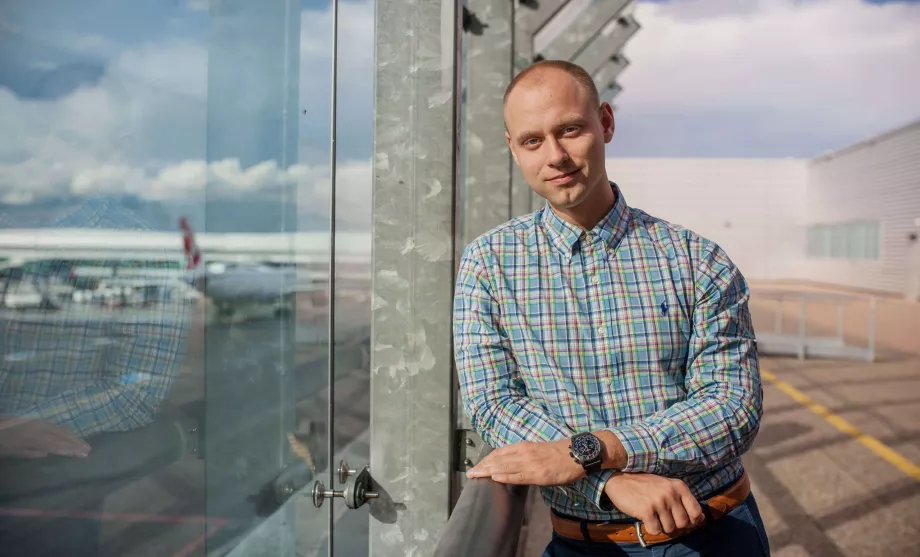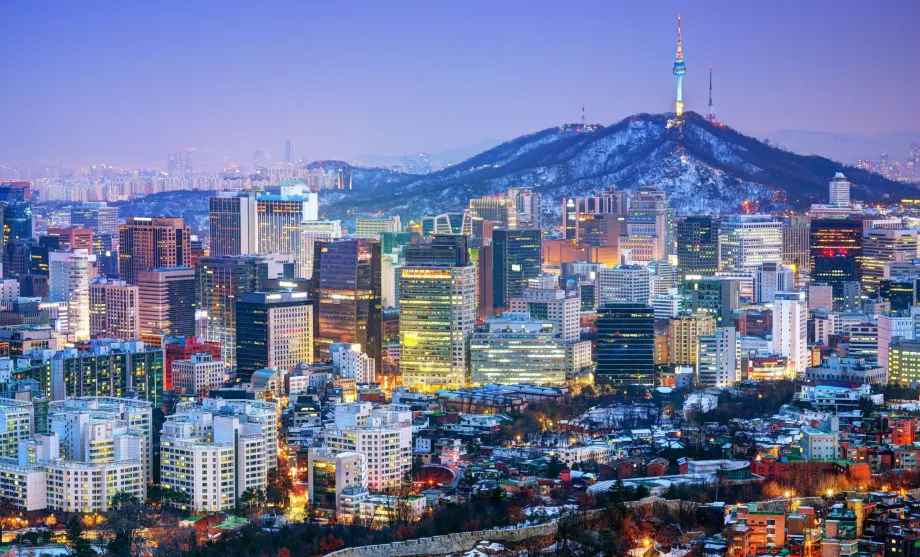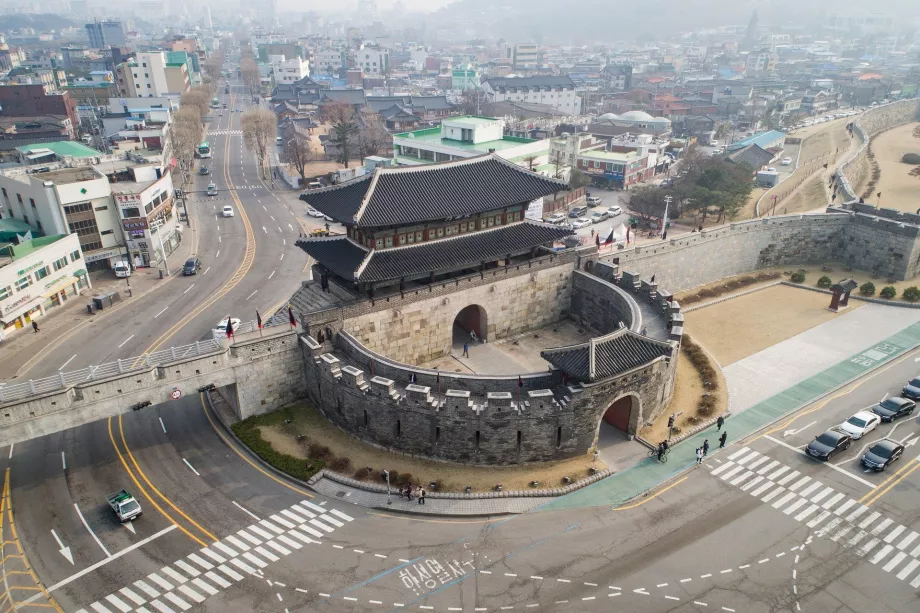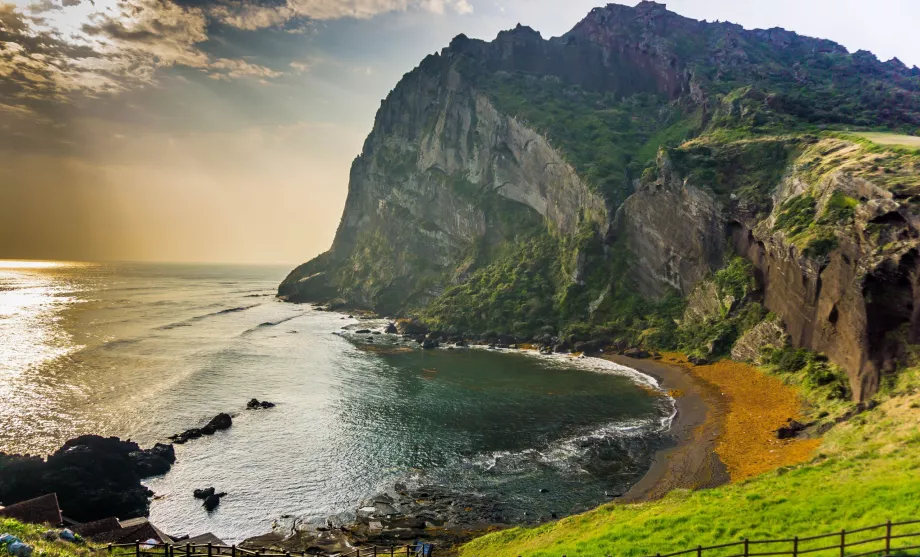Demilitarised Zone (DMZ)
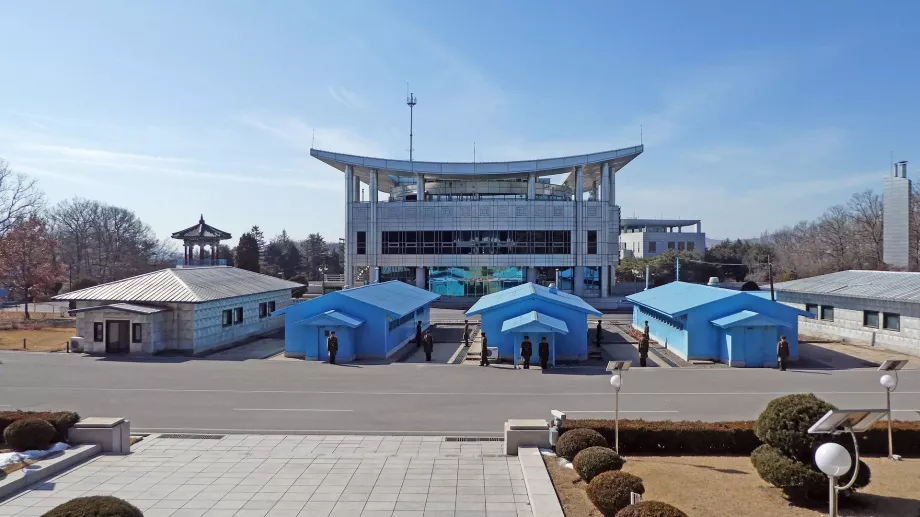
The Korean Demilitarized Zone (almost exclusively abbreviated "DMZ") is a strip of land forming the border between South and North Korea roughly around the 38th parallel. It divides the Korean peninsula roughly in half. The two completely different worlds...
The DMZ extends from sea to sea, 250 km long, with about 2-4 km on each side of the border. The zone was established in 1953 immediately after the armistice in the Korean War to serve as a buffer zone between the two Koreas.
No troops are present on either side of the border in the demilitarised zone. The exception is the so-called Joint Security Area in the village of Panmunjom - the only one between the touching points of South and North Korea.
On the South Korean side, the DMZ is one of the most popular tourist destinations with many monuments and views of North Korea.
Is it possible to visit the DMZ?
Tourist routes directly to the DMZ are only possible in one location. You can go to the village of Pchanmunjom in the Joint Security Area, where you will be as close to the North Korean border as possible. However, it always depends on the current political situation and tensions between the two Koreas. The Joint Security Area is so often an inaccessible area for tourists.
All other tourist attractions do not lie directly in the DMZ, but in another buffer zone called the Civilian Control Line or also the Civilian Control Zone. This is an area that civilians and tourists can enter, but are always subject to passport control by the Korean military.
The only inhabited village directly in the DMZ, which is Daeseongdong (also Tesong-dong or Josan), is off-limits to the public.
What to see in and around the DMZ?
The border of the DMZ and the Civil Line of Control is filled with tourist sites, monuments, military attractions and observation platforms with telescopes from which to spy on North Korea.
Joint Security Area (Panmunjon)
The only point of contact between South and North Korea, the Joint Security Area, has grown up on the site of the former Panmunjon farming village. This neutral area was created immediately after the armistice in the Korean War in 1953 as a meeting place for the leaders of the two Koreas.
The Joint Security Area (JSA) is divided by the Military Demarcation Line (MDL) into North and South Korean parts. The original idea was that free movement within the JSA would be possible for both sides, but after the 1976 incident the MDL was established and this movement is not possible.
Currently, a maximum of 35 unarmed guards are allowed on each side. The JSA is the only place where soldiers from both countries see each other face to face.
The site can only be visited with an organized tour. You will see the following places:
- The Blue Houses on the MDL - an iconic trio of blue houses (in UN colors) located right on the Green Line. They are used for occasional meetings between representatives of the two Koreas, and occasionally between separated families from both countries. They are the only place where as a tourist coming from South Korea you are allowed to cross the MDL for a few minutes (however, it always depends on the current situation).
- Freedom House - a large building on the South Korean side designed for basic communication between the two countries and especially for communication between the Red Crosses of both countries
- Peace House - a smaller building on the South Korean side for diplomatic negotiations
- Blue Bridge - a pedestrian shortcut across the swamps between the main part of the JSA and the Neutral Observer Mission staff quarters
- Bridge of No Return - a bridge over the Sacheon River between the two Koreas used for prisoner exchanges. Once crossed, there was no turning back. It is currently inaccessible to the public
Tunnels of Aggression
Under the Demilitarized Zone, four tunnels were discovered during the 1970s to 1990s, dug by the North Korean side for a surprise attack on Seoul. However, it is believed that there may be as many as 20 tunnels. The South Korean side calls them the Tunnels of Aggression and they are now partially open to tourists.
The most popular tourist attraction is Tunnel 3, which has the largest capacity and most extensive facilities for tourists, including a train that runs through the tunnel to below the physical border of the two Koreas deep in the DMZ. It is also the closest to Seoul.
All tunnels can only be visited through organized tours.
Dorasan Station and Dora Viewpoint
The modern railway station on the border of the Civil Control Zone and the Demilitarized Zone has symbolic significance and represents the hope that one day it will be possible to take a regular passenger train from Seoul across the border to Pyongyang.
Dorasan Station is also the only border station with working tracks between the two Koreas. It is also located at one of two road border crossings that will hopefully be used for travel between South and North Korea at some point in the future.
Near the station (about 2 km) from the station you will find the most visited Dora Observatory, from which you can see all the way to North Korea via the DMZ.
Visiting both places is also possible on your own, or without an organized tour by a special train "DMZ-Train" from Seoul. More details can be found in the chapters below.
Imjingak
Imjingak Park is a large memorial site with many monuments, memorials and small museums, all related to the Korean War. Imjingak Resort is before the Civil Control Zone and therefore outside the DMZ, so travel here is free without the need for documents. However, you will already need these for, for example, the cable car ride across the Imjin River.
Admission to all sites is free.
The most popular sights at Imjingak Resort include:
- Bridge of Freedom - a wooden pedestrian bridge connecting Imjingak Park with the railway bridge over the river (Freedom Bridge).
- Peace Train and Colorful Fence - an old rusty locomotive, which in 1950 was the last train to cross the Korean border, is on display at the original Freedom Bridge. The surrounding fence that separates Imjingak from the Civil Control Zone is then covered with coloured papers with prayers for the reunification of Korea
- National Memorial Hall of the Korean War - a memorial hall with information about the Korean War
- Pyeonghwa Land - a small amusement park with rides or bumper cars especially for children
Imjingak Cable Car (DMZ Gondola)
In 2019, a new cable car was built across the Imjin River to take you through the Civil Control Zone to the border of the Demilitarized Zone. From the terminal station, you can then walk along a special path surrounded by a high fence for about 350 metres to a viewing platform overlooking the river and part of the DMZ. North Korea, however, can be seen from here as far as the horizon.
As the cable car already passes through the Civil Control Line, you need to go through passport control.
The fare can only be purchased round trip and goes out at 11 000 krw (or 14 000 krw in a glass-floored cabin).
Official information: english.visitkorea.or.kr
Daeseong-dong Village
The only currently inhabited village directly in the DMZ is called Daeseong-dong (also known as Freedom Village in South Korea) and has somewhere between 150 and 200 inhabitants, mostly farmers. It is not open to the public. However, from the Dora viewpoint, a 98-metre high flagpole with the South Korean flag can be seen.
Also visible on the North Korean side is the village of Kijong-dong (also known as the Propaganda Village in South Korea) with a 160-metre-high flagpole flying the North Korean flag.
How to visit the DMZ?
Places directly in the Demilitarized Zone can only be visited with an organized trip through one of the Korean travel agencies (mainly based in Seoul). You can also visit places on the edge of the DMZ or completely outside the DMZ on your own, or you can drive to the DMZ border and join an organized tour to Dorasan Station without having to do anything in Seoul.
Organized Tours
An organized tour to the DMZ is especially beneficial if you want to see the biggest attraction, the Joint Security Area. There is no other way to get to this area and there are even periods when even organized tours are interrupted.
These tours also save a lot of time, as public transport to Imjingak or Dorasan station runs only a few times a day and is also about twice as time consuming as an organised tour.
There is also the advantage of being able to choose between half-day and full-day trips.
What are the prices of the trips?
Prices vary slightly from tour company to tour company. We recommend booking online at least a few days in advance.
- Half-day trip (approx. 7:00 to 14:00 or 11:00 to 18:00) - around 80 000 krw up to 90 000 krw
- full day tour (approx. 7:30 am to 5:00 pm) - around 110 000 krw
Generally, we recommend using more half-day tours, during which you will get around most of the attractions anyway and there will be less downtime or annoying stops at souvenir shops.
Examples of agencies
Transportation on your own
Going to the DMZ on your own will definitely save you money, but on the other hand it will always take you a full day. You basically only have two options for transport to the DMZ, or at least to the DMZ border.
DMZ Peace Train
The most popular option is to use the special DMZ Peace Train, which runs once a day from Seoul (from Yongsan and Seoul Station) to Dorasan Station.
Here you will find that this way of travel is not so much on your own. At Dorasan Station, you have to transfer to the buses that will take you to the Dora Viewpoint and the 3rd Tunnel Tour. The downside is that there are currently only Korean-language services available on these buses.
The train leaves Seoul around 10:00am and returns before 6:00pm.
- Price - 36 000 krw (return train ticket + tourist bus ride)
- Purchase your ticket at the Let's Korail office at both Seoul train stations (ideally at least one day before departure)
- DMZ Peace Train does not run on Mondays, Tuesdays and public holidays
- Official information: english.visitkorea.or.kr
Upon arrival in Seoul, always check with any Korail ticket office to make sure the DMZ Peace Train is in operation. There are periods of heightened tension between the Koreas when the train is not running.
You will need to get off at Imjingak station on the way, where passport control will take place!
Transportation to the Imjingak area
The Imjingak memorial site, with its cable car across the river and several memorials, is easily accessible without checking.
By train - take the Gyeongui-Jungang suburban railway line (turquoise) to Munsan station (about 60 minutes from central Seoul). Here you need to change to another train, which will take you to Imjingak Station in 15 minutes.
- Munsan -> Imjingak: weekdays 10:30 and 16:55, weekends 9:35, 10:35, 15:45 and 17:20
- Imjingak -> Munsan: weekdays 10:50 and 17:15, weekends 10:00, 12:20, 16:10 and 17:45
- Timetables and connection search: www.seoulmetro.co.kr
- Price approx. 4 000 krw one way
By bus - on weekends, there is a direct 7300 bus from central Seoul (Hongik University Station, where the Airport Railroad, Gyeongui-Jungang and Green Line 3 lines stop) every hour on the hour. The journey takes about 2 hours and costs around 2 000 krw.
When is the DMZ open to the public?
All attractions in the Demilitarized Zone and the Civil Control Zone are closed on Mondays and Korean holidays. The DMZ Peace Train does not run on Tuesdays. The Joint Security Area is closed on Sundays and Thursdays.
On the other hand, all places beyond the border of the controlled zones (Imjingak or Odosan or Ganghwa viewpoints) are open all week long.
Is it safe to visit the DMZ?
Even if you sign a paper at the checkpoint and between the Civil Control Line and the Demilitarised Zone that you are entering a dangerous area where your safety is not guaranteed, there is virtually no real danger.
In fact, in times of heightened political or military tension, all tours and opportunities to travel on your own are forbidden.
Dress Code when travelling to the DMZ
Parts of the Korean Demilitarized Zone (and especially the Panmunjon/Joint Security Area) require a strict dress code. And travel companies that organize organized trips actually require it from tourists.
Indeed, there are cases where North Korean propaganda uses tourists' eccentric dress to show its people how perverse and rotten "Western civilization" is.
So what not to wear when travelling to the DMZ?
- Frayed/torn trousers
- Sports or athletic clothing (leggings, shorts, tank tops)
- T-shirts without sleeves
- Tight clothing (i.e., high necked shirts or miniskirts)
- Shorts/skirts above the knee
- Sandals or flip-flops
- Clothes with a military pattern
These rules only apply to direct visits to the Demilitarised Zone or certain sites in the adjacent Civil Zone (e.g. Dora Observatory). Other places on the borders of the zone are not covered by the dress code (Imjingak, Ganghwa, Odusan or Goseong viewpoints).
Passport control
You must carry your passport whenever you cross the Civil Control Line. This therefore applies to visiting the following sites:
- Joint Security Area (Panmunjon)
- Dora Observatory
- Dorasan Station
- All Tunnels of Aggression
- Imjingak Gondola
Photography
Photography is allowed at all tourist sites. Exceptions are some rooms in the Joint Security Area.
Then you are not allowed to use lenses with a focal length greater than 90 mm at Dora Observatory.
What to see around
Discover all the places to see in South Korea.
Any questions left?
If you have any questions or comments about the article...
